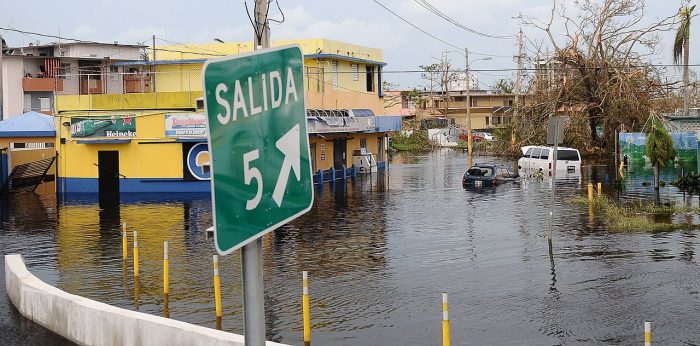

Flooding in Carolina, Puerto Rico (Public Domain)
Originally published at Latino USA.
Data from the Puerto Rico Institute of Statistics published by the Los Angeles Times on Wednesday confirmed earlier data analyses from Latino USA and the Center for Investigative Journalism (CPI) that excess deaths on the island for the last part of 2017 —when two hurricanes struck the island— were greater than the same time period in 2016.
As the LA Times story states: “The total number of deaths above average in September, October and November was 1,230, according to Alexis Santos, a demographer at Pennsylvania State University who obtained the data from the Puerto Rico Institute of Statistics and conducted an analysis that he released to the Los Angeles Times this week.”
After Santos’ analysis was published in the LA Times, Latino USA reached out to him for a copy of the data he received from the Puerto Rico Institute of Statistics, which lists deaths on the island per month since 2010. The following chart used data collected up until January 2. It notes that data collection for the months of November and December 2017 are not complete.


Yet even with limited data for November and December, the total number of deaths for the last four months for 2017 in Puerto Rico was 10,617. For the last four months of 2016, that number was 9,964.


Based on this data, there were 540 excess deaths in September 2017, when compared to September 2016, and 650 excess deaths in October 2017, when compared to October 2016. Hurricane María struck Puerto Rico on September 20, about two weeks after Hurricane Irma passed the island.
A January 4 analysis by Latino USA using the last updated data from Puerto Rico’s Department of Health (January 2 statistics) shared similar information to Santos’ analysis in the LA Times. In that January analysis, there were 537 more deaths in September 2017 when compared with September 2016, and 657 more deaths in October 2017 when compared to October 2017. The total two months combined would be 1,194 more deaths—making September 2017 and October 2017 the two months with the most deaths in Puerto Rico for the last three years.


The January 4 Latino USA analysis also included incomplete information for November, although initial November 2017 data shows a small increase, when compared to November 2016.


The latest analysis from Santos and LA Times comes a week after the government of Puerto Rico announced that the Milken Institute School of Public Health at George Washington University will be conduct a recount of the Hurricane María death toll. Currently, the official death count, according to the administration of governor Ricardo Rosselló, is at 64, although reporting by the CPI/Latino USA, as well as The New York Times and an earlier study by Santos that all used public demographic data suggested that the death count associated with the hurricane could be more than 1,000 people.
The GW team is expected to make its initial study public some time in May.
After Latino USA kept asking for additional updates to the January 4 death toll statistics, a spokesperson for the island’s Department of Public Security said on February 1 there will be no more updates to Hurricane María-related deaths shared with the public until a formal report order by the governor is completed. The governor’s executive order was announced on January 4, the last day the government of Puerto Rico shared public death statistics with Latino USA. The order now applies to the release of the GW study.
On February 12, a spokesperson for the island’s Department of Health told Latino USA that “…until [the death toll] investigation is completed, and by recommendation of the CDC itself, we are not authorized to provide new mortality data for the year 2017.” The spokesperson expected to have new data by June or July.
The decision by the government of Puerto Rico to not share any new data since early January led to a CPI lawsuit demanding that updated data since then be made public.
The LA Times story also reported that Santos concluded “that the higher death rate in November occurred despite a declining population on the island, which had 3.4 million people before the hurricane. More than 87,000 people are thought to have since moved to the U.S. mainland.”
Puerto Rico’s Institute of Statistics, an independent government agency with a history of correcting inaccuracies in data reporting by other government departments (including reports from the Department of Health), is facing the possibility of getting cut, due to the island’s fiscal problems.
***
Julio (Julito) Ricardo Varela is the founder of Latino Rebels, co-host of In The Thick and a frequent contributor to Latino USA. He tweets from @julito77.


